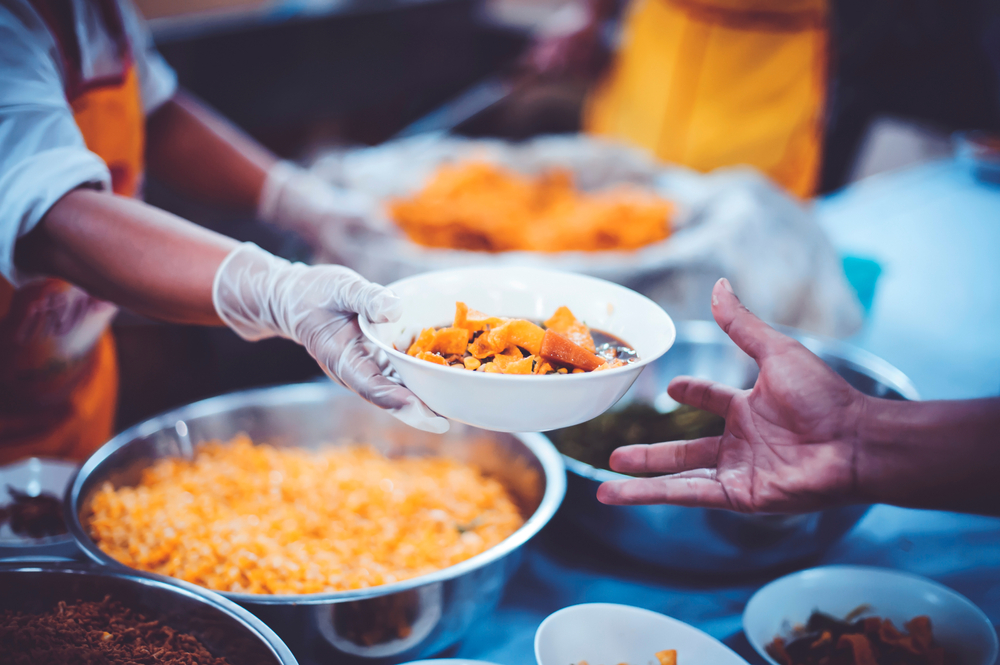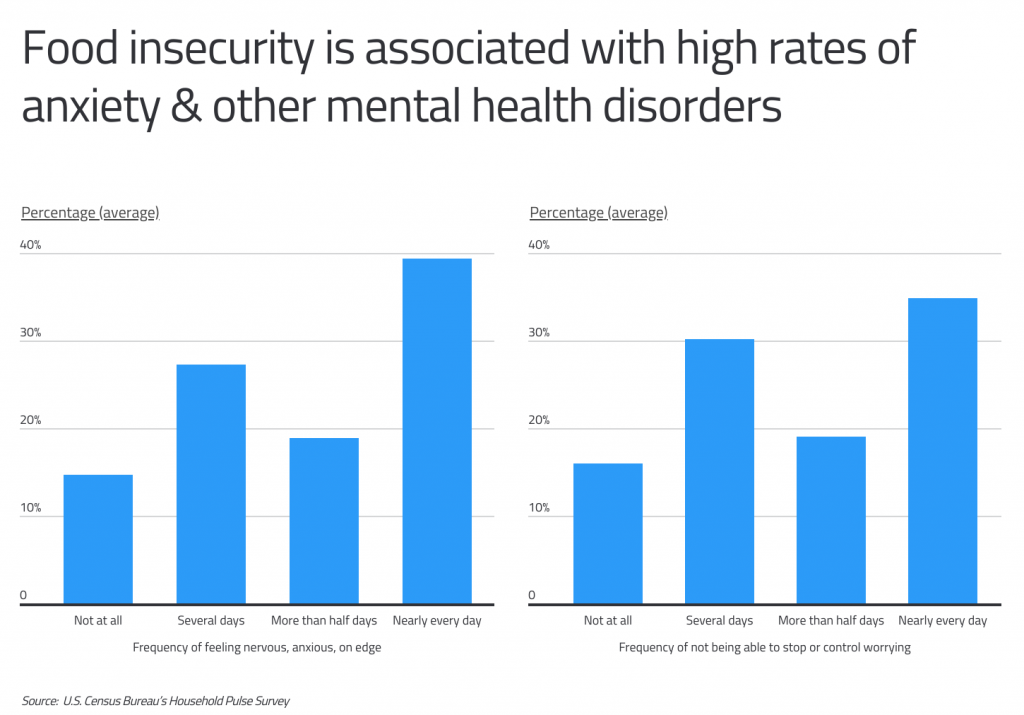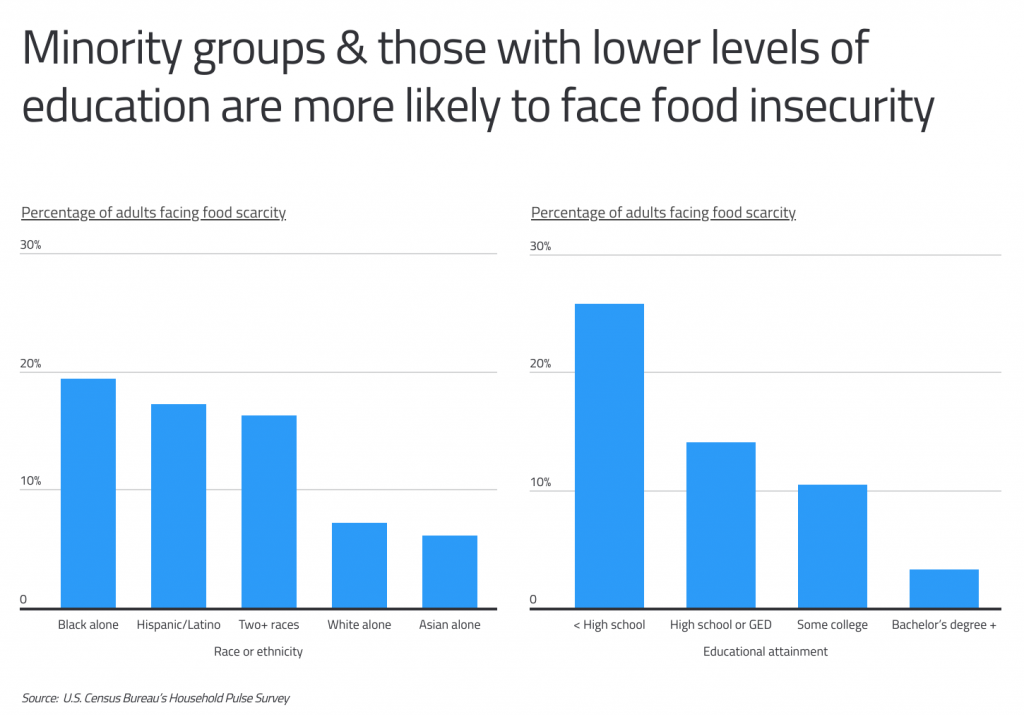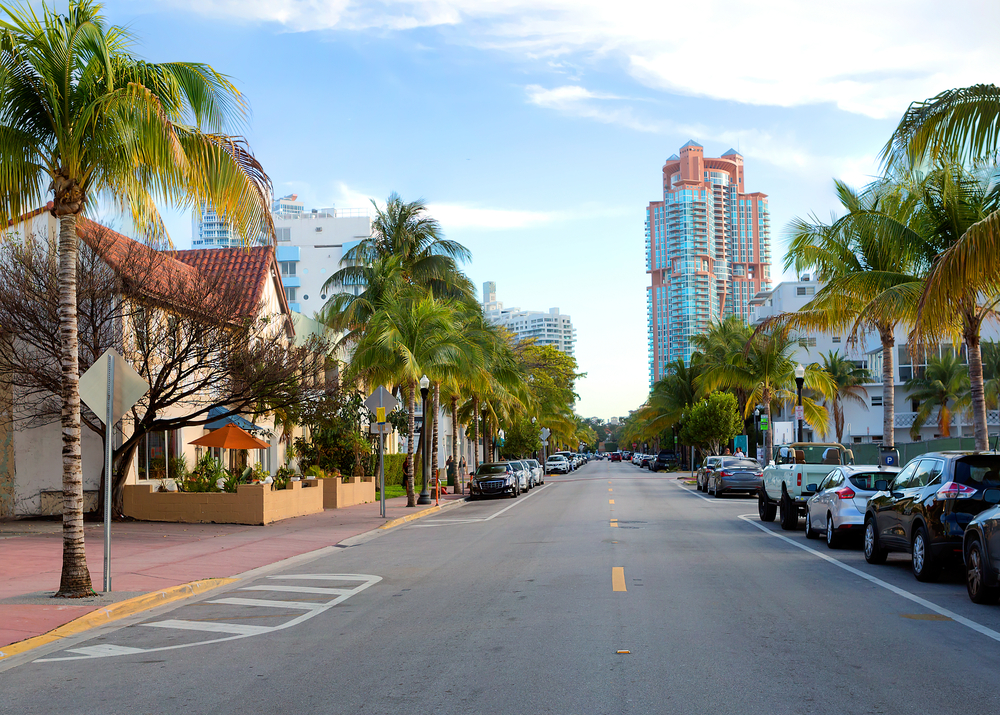
Photo Credit: addkm / Shutterstock
The COVID-19 pandemic created economic hardship for millions of Americans. With the onset of the pandemic in the spring of 2020, the U.S. unemployment rate spiked to 14.8%, and while many jobs quickly returned, millions of workers—many of whom previously worked in lower-wage positions—are still unable to find work or have dropped out of the workforce. Despite robust government efforts to provide relief to households, many families have struggled to meet their basic needs throughout the pandemic, with more ripple effects possible as a result.
One example is food insecurity, a condition defined by the disruption of food intake or eating patterns typically due to a lack of economic resources. Because households need money to obtain an adequate, nutritious supply of food, unemployment is a major factor that contributes to food insecurity. And with the heightened unemployment seen as a result of the pandemic, up to 42 million Americans could face food insecurity at some point this year, according to a report from Feeding America.
Food insecurity is more than a consequence of economic hard times: it is also associated with a variety of health conditions. For one, food insecurity correlates strongly with obesity, as many food insecure individuals are less likely to access or afford fresh, nutritious foods and instead rely more heavily on highly processed items. Chronic disease is also exacerbated by food insecurity, particularly conditions like diabetes, hypertension, or heart disease that are highly affected by diet. And in children, who are one of the most food-insecure populations, poor or inconsistent diets due to food scarcity can contribute to developmental problems.
Food scarcity’s effects on health also extend to mental and emotional wellbeing. This has been particularly true during the pandemic, according to data from the U.S. Census Bureau’s Household Pulse Survey, which surveys U.S. adults on a variety of social and economic indicators each week. Nearly 40% of those who reported that they had sometimes or often not had enough to eat in the prior week also indicated that they felt nervous, anxious, or on edge nearly every day. Further, 35% of those facing food scarcity reported that they were unable to stop or control worrying nearly every day.

And some populations are disproportionately affected by food insecurity when compared to others. One strongly correlated factor is race and ethnicity. Nearly one in five black Americans (19.4%) reported facing food scarcity, with 17.2% of Hispanic Americans and 16.2% of multiracial Americans. In contrast, only 7.2% of White Americans are food insecure, while Asians fare best of all at 6.1%. Disparities are even starker by educational attainment: more than a quarter (25.8%) of Americans who have not completed high school reported food insecurity during the pandemic, compared to 14.1% of those who hold a high school diploma or GED and a mere 3.3% of those with a bachelor’s degree or higher.

Because of food insecurity’s links to other population characteristics, some locations have a higher concentration of food insecure residents than others. Most of the states with the highest rates of food insecurity are located in the South, where the Black population is larger, educational attainment rates are lower, and residents face high levels of poverty and unemployment. The South accounts for nine of the top 10 states with the most food scarcity and 12 of the top 15.
To determine the states with the most residents facing food scarcity, researchers at Commodity.com calculated the percentage of adults in households where there was either sometimes or often not enough to eat, averaged over all available weeks of the Household Pulse Survey. As such, the data represents the typical percentage of adults facing food scarcity at any given point in time during the pandemic, not the cumulative number of people ever facing food scarcity. In the event of a tie, the state with the higher average number of adults facing food scarcity was ranked higher. Researchers also gathered data on poverty and unemployment rates for each of the top states.
Here are the states with the most residents facing food scarcity.
States With the Most Residents Facing Food Scarcity

Photo Credit: Victor Moussa / Shutterstock
15. New York
- Percentage of adults facing food scarcity: 10.9%
- Total adults facing food scarcity: 1,426,103
- Poverty rate: 13.0%
- 2020 average unemployment rate: 10.0%

Photo Credit: Sean Pavone / Shutterstock
14. Tennessee
- Percentage of adults facing food scarcity: 11.1%
- Total adults facing food scarcity: 522,885
- Poverty rate: 13.9%
- 2020 average unemployment rate: 7.5%

Photo Credit: Jonny Trego / Shutterstock
13. Kentucky
- Percentage of adults facing food scarcity: 11.3%
- Total adults facing food scarcity: 341,658
- Poverty rate: 16.3%
- 2020 average unemployment rate: 6.6%

Photo Credit: stellamc / Shutterstock
12. New Mexico
- Percentage of adults facing food scarcity: 11.3%
- Total adults facing food scarcity: 163,444
- Poverty rate: 18.2%
- 2020 average unemployment rate: 8.4%

Photo Credit: Sean Pavone / Shutterstock
11. West Virginia
- Percentage of adults facing food scarcity: 11.4%
- Total adults facing food scarcity: 142,045
- Poverty rate: 16.0%
- 2020 average unemployment rate: 8.3%

Photo Credit: f11photo / Shutterstock
10. South Carolina
- Percentage of adults facing food scarcity: 11.7%
- Total adults facing food scarcity: 420,756
- Poverty rate: 13.8%
- 2020 average unemployment rate: 6.2%

Photo Credit: Galina Savina / Shutterstock
9. Florida
- Percentage of adults facing food scarcity: 11.8%
- Total adults facing food scarcity: 1,796,424
- Poverty rate: 12.7%
- 2020 average unemployment rate: 7.7%

Photo Credit: Kevin Hearn / Shutterstock
8. Oklahoma
- Percentage of adults facing food scarcity: 11.9%
- Total adults facing food scarcity: 315,640
- Poverty rate: 15.2%
- 2020 average unemployment rate: 6.1%

Photo Credit: Luciano Mortula-LGM / Shutterstock
7. Georgia
- Percentage of adults facing food scarcity: 12.0%
- Total adults facing food scarcity: 847,635
- Poverty rate: 13.3%
- 2020 average unemployment rate: 6.5%

Photo Credit: Virrage Images / Shutterstock
6. Nevada
- Percentage of adults facing food scarcity: 12.1%
- Total adults facing food scarcity: 262,158
- Poverty rate: 12.5%
- 2020 average unemployment rate: 12.8%

Photo Credit: Trong Nguyen / Shutterstock
5. Arkansas
- Percentage of adults facing food scarcity: 12.5%
- Total adults facing food scarcity: 251,179
- Poverty rate: 16.2%
- 2020 average unemployment rate: 6.1%

Photo Credit: Sean Pavone / Shutterstock
4. Alabama
- Percentage of adults facing food scarcity: 12.9%
- Total adults facing food scarcity: 426,266
- Poverty rate: 15.5%
- 2020 average unemployment rate: 5.9%

Photo Credit: D Guest Smith / Shutterstock
3. Texas
- Percentage of adults facing food scarcity: 13.0%
- Total adults facing food scarcity: 2,484,208
- Poverty rate: 13.6%
- 2020 average unemployment rate: 7.6%

Photo Credit: evenfh / Shutterstock
2. Louisiana
- Percentage of adults facing food scarcity: 14.6%
- Total adults facing food scarcity: 441,907
- Poverty rate: 19.0%
- 2020 average unemployment rate: 8.3%

Photo Credit: Sean Pavone / Shutterstock
1. Mississippi
- Percentage of adults facing food scarcity: 15.4%
- Total adults facing food scarcity: 299,575
- Poverty rate: 19.6%
- 2020 average unemployment rate: 8.1%
Detailed Findings & Methodology
The data used in this analysis is from the U.S. Census Bureau’s Household Pulse Survey, the U.S. Census Bureau’s American Community Survey 1-Year Estimates, and the U.S. Bureau of Labor Statistics’ Local Area Unemployment Statistics. To determine the states with the most residents facing food scarcity, researchers calculated the percentage of adults in households where there was either sometimes or often not enough to eat in the last seven days. In the event of a tie, the state with the higher total number of adults facing food scarcity was ranked higher. All statistics reported are averages of the weekly data available from the Household Pulse Survey. As such, the data represents the typical percentage of adults facing food scarcity at any given point in time during the pandemic, not the cumulative number of people ever facing food scarcity.


